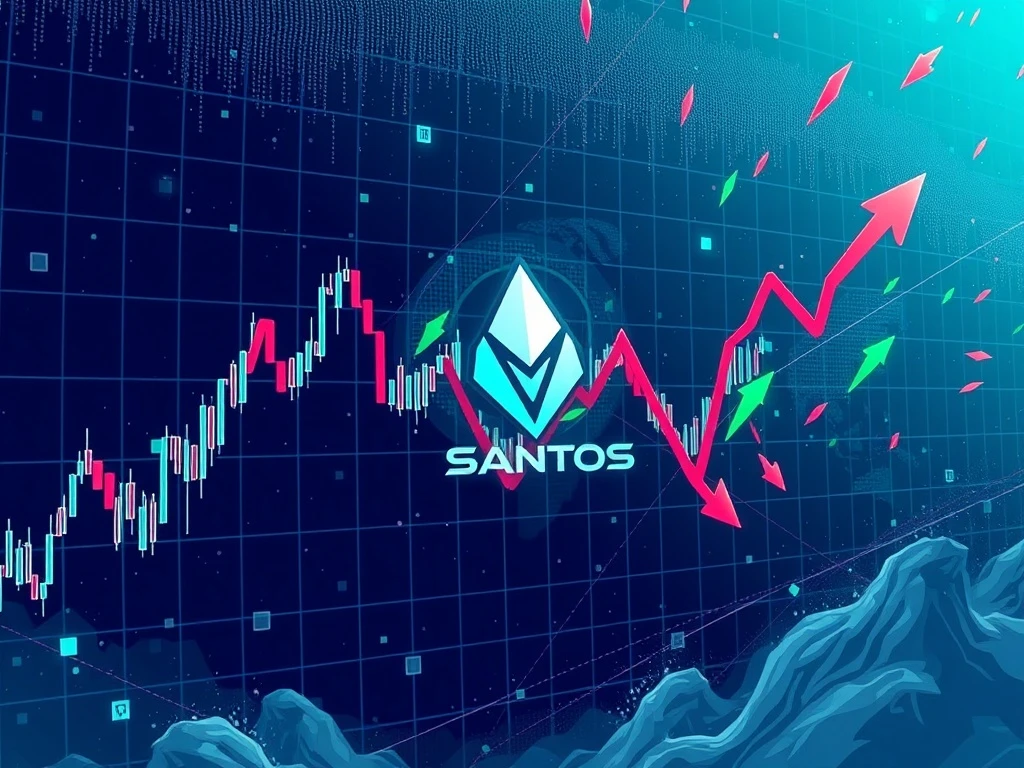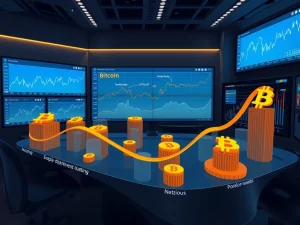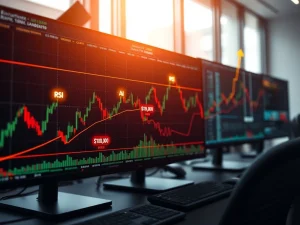SANTOS Token’s Turbulent Plunge: An Unprecedented 485.22% Reported Drop Amidst Crypto Volatility

The cryptocurrency market is renowned for its dynamic and often unpredictable nature, offering both exhilarating opportunities and significant risks. Among the myriad of digital assets, the SANTOS Token has recently become a prime example of this inherent unpredictability, experiencing what has been reported as an unprecedented and mathematically anomalous 485.22% drop within a 24-hour period. While such a percentage decline exceeds the realm of mathematical possibility for a direct price drop (as an asset cannot lose more than 100% of its value), this figure, as reported, powerfully underscores the extreme crypto volatility that can grip even established projects.
This article delves into the various facets of SANTOS’s recent movements, exploring not just the startling price action but also the critical regulatory developments, evolving blockchain governance, strategic ecosystem expansions, and vital tokenomics adjustments that are currently shaping its future. For traders and investors navigating this turbulent landscape, understanding these underlying factors is crucial to making informed decisions.
Understanding the Unprecedented SANTOS Price Movements: What Happened?
On July 28, 2025, the SANTOS price was reported to have plummeted by an extraordinary 485.22% within 24 hours, reaching a low of $2.504. While a percentage drop exceeding 100% from a given point is not possible in standard financial terms, such reported figures often indicate extreme illiquidity, a significant data anomaly, or a misinterpretation of a flash crash scenario on a specific exchange where prices momentarily hit zero or near-zero before recovery. Regardless of the exact mathematical interpretation, the intent of the report is clear: SANTOS experienced a period of extreme short-term volatility that caught many off guard.
This dramatic single-day event contrasts sharply with the token’s performance across other timeframes:
- 7-Day Performance: Prior to the drop, SANTOS had seen a staggering rise of 1250.56% over seven days.
- 1-Month Performance: Over the preceding month, it surged by an even more remarkable 3465.67%.
- 1-Year Performance: Looking at the broader picture, the token had dropped by 2195.27% over the past year, indicating a prolonged period of decline punctuated by intense short-term rallies.
Such a rollercoaster ride highlights the speculative nature of many altcoins. For investors, this pattern of sharp rallies followed by equally sharp corrections or even unprecedented reported declines emphasizes the critical importance of risk management, including setting stop-loss orders and diversifying portfolios. It also serves as a stark reminder that reported data, especially in nascent markets, should always be cross-referenced and verified from multiple reliable sources.
Navigating Regulatory Scrutiny and Enhancing Blockchain Governance
Beyond the dizzying price charts, the SANTOS Token has found itself under increased regulatory scrutiny. An internal review conducted by its compliance department reportedly uncovered inconsistencies in the project’s token distribution model, particularly concerning early-stage allocations. This type of scrutiny is becoming increasingly common in the crypto space as regulators worldwide push for greater transparency and investor protection. While SANTOS has yet to issue a public statement regarding these findings, industry observers are keenly watching, suggesting that the results could significantly influence future blockchain governance decisions and operational practices.
In a proactive move to address growing community concerns and bolster trust, the SANTOS development team announced the formation of a new governance working group. This initiative is a crucial step towards fostering a more decentralized and transparent decision-making framework. The group, which includes core developers, token holders, and external auditors, is tasked with:
- Proposing Structural Reforms: Developing concrete proposals to refine and improve the project’s decision-making processes, moving towards a more community-driven model.
- Increasing Transparency: Implementing mechanisms to ensure greater visibility into project operations, financial dealings, and development progress.
- Aligning Stakeholder Interests: Ensuring that the long-term goals of the project are in harmony with the interests of its diverse community, from early investors to new users.
This commitment to robust blockchain governance is vital for long-term sustainability, as it can help mitigate risks associated with centralized control and enhance the project’s credibility in the eyes of both retail and institutional investors.
Strategic Ecosystem Expansion and Critical Tokenomics Adjustments
Despite the challenges posed by market fluctuations and regulatory reviews, the SANTOS Token project continues to build out its ecosystem. A significant recent development is the integration of a new decentralized oracle network, confirmed via on-chain activity. Decentralized oracles are crucial bridges that connect blockchain smart contracts with real-world data, enabling a vast array of sophisticated applications. This integration is expected to:
- Enhance Smart Contract Capabilities: Provide smart contracts on the SANTOS platform with reliable, tamper-proof external data feeds.
- Improve Data Verification: Ensure the accuracy and integrity of data used for various on-chain operations, from pricing to event triggers.
- Strengthen Real-Time Analytics: Facilitate the development of applications that require up-to-the-minute information, improving the reliability of automated functions across the network.
Developers have emphasized that this update will significantly improve the robustness and utility of applications built on the SANTOS network, potentially attracting new developers and users to its growing ecosystem.
In parallel, a major tokenomics update was implemented over the weekend, signaling a strategic shift in how network participation is incentivized. The new model revises the staking reward structure:
- Reduced APY for Long-Term Stakers: The Annual Percentage Yield (APY) for those locking up tokens for extended periods has been decreased.
- Increased Rewards for Shorter Lock-up Periods: Conversely, incentives for shorter staking durations have been boosted.
This adjustment is designed to encourage more active and frequent participation in the network’s consensus mechanisms, aiming to reduce the concentration of tokens in long-term, passive holdings. By promoting a more dynamic staking environment, SANTOS seeks to enhance network decentralization and security through broader, more active engagement from its community members.
Developer Activity and the Future Roadmap for SANTOS Token
A key indicator of a blockchain project’s health and commitment is its developer activity. The SANTOS GitHub repository has shown a notable increase in engagement over the past month, with 23 new commits and three major pull requests successfully merged. These technical updates are foundational, demonstrating continuous improvement and innovation. Among the key updates are:
- Improvements to the Consensus Layer: Enhancements to how network participants agree on the state of the blockchain, crucial for speed, security, and finality of transactions.
- Introduction of a New Validation Node Architecture: This could lead to more efficient, scalable, and secure network operations, potentially lowering barriers for new validators.
Looking ahead, the project’s roadmap includes an ambitious mid-August release of a major version update. This upcoming update is slated to focus heavily on two critical areas for any modern blockchain:
- Scalability: Addressing the ability of the network to handle increasing transaction volumes without compromising speed or incurring high fees.
- Cross-Chain Interoperability: Enabling seamless communication and asset transfer between the SANTOS network and other blockchains, a vital feature for integration into the broader DeFi ecosystem.
These roadmap milestones suggest a clear vision for the technical advancement of the SANTOS Token, aiming to position it competitively within the fast-evolving decentralized landscape.
Analyst Outlook: Can SANTOS Navigate the Persistent Crypto Volatility?
Analysts are closely monitoring the unfolding situation, projecting that the recent regulatory and governance developments could pave the way for a period of stabilization for the SANTOS Token in the coming weeks. This optimistic outlook, however, is largely contingent on the governance working group delivering concrete and effective proposals that restore and build investor confidence. The market’s reaction to such reforms will be a true test of the project’s resilience.
However, the sharp reported price decline in the last 24 hours serves as a stark reminder of the asset’s continued sensitivity to news cycles, market sentiment, and overall crypto volatility. In the highly reactive world of digital assets, even rumors or unconfirmed reports can trigger significant price movements. Investors are advised to remain cautious, conducting thorough due diligence and staying abreast of official announcements from the SANTOS team. The path to sustained growth in such a dynamic environment requires robust fundamentals, clear communication, and adaptable strategies.
Conclusion: What’s Next for SANTOS Token in a Volatile Market?
The journey of the SANTOS Token has been a microcosm of the broader cryptocurrency market itself: unpredictable, exhilarating, and challenging. From an unprecedented reported short-term price plunge to significant long-term gains, SANTOS embodies the very essence of crypto volatility. Yet, amidst these turbulent waters, the project has demonstrated a proactive stance in addressing critical issues.
The commitment to enhancing blockchain governance, navigating regulatory scrutiny, strategically expanding its ecosystem, and fine-tuning its tokenomics are all vital steps towards building a more resilient and sustainable future. As the development team continues to push forward with crucial updates focused on scalability and cross-chain interoperability, the community remains vigilant. While the inherent unpredictability of the crypto market persists, SANTOS’s efforts towards transparency and technical advancement suggest a determination to carve out its niche. For both current and prospective investors, continuous research, careful risk management, and a keen eye on official project developments will be paramount in understanding the true trajectory of this dynamic digital asset.
Frequently Asked Questions (FAQs) About SANTOS Token
Q1: What does the reported -485.22% drop in SANTOS Token price signify?
While a percentage drop exceeding 100% is mathematically impossible for a direct price decline, this reported figure likely indicates an extreme market event such as a flash crash on a specific exchange, a data reporting anomaly, or severe illiquidity. It serves as a dramatic illustration of the intense short-term crypto volatility that SANTOS Token has experienced, rather than a literal percentage loss from its value.
Q2: How is SANTOS addressing concerns about its token distribution and blockchain governance?
SANTOS has formed a new governance working group composed of core developers, token holders, and external auditors. This group is tasked with proposing structural reforms to the project’s decision-making processes, aiming to increase transparency, align with stakeholder interests, and address inconsistencies highlighted by an internal compliance review regarding token distribution.
Q3: What are the key features of the recent Tokenomics adjustments for SANTOS?
The recent tokenomics update alters the staking reward structure. It reduces the Annual Percentage Yield (APY) for long-term stakers while increasing rewards for shorter lock-up periods. This shift is intended to encourage more active participation in the network’s consensus mechanisms and reduce the concentration of tokens in long-term, passive holdings, promoting broader decentralization.
Q4: How does the new decentralized oracle integration benefit the SANTOS ecosystem?
The integration of a new decentralized oracle network enhances the SANTOS platform’s smart contract capabilities by providing reliable, real-time external data. This improves data verification, strengthens real-time analytics, and increases the reliability of automated functions across the network, paving the way for more robust decentralized applications (dApps).
Q5: What are SANTOS’s upcoming development priorities according to its roadmap?
The SANTOS project’s roadmap includes a major version update slated for mid-August. This update will primarily focus on improving scalability, allowing the network to handle higher transaction volumes more efficiently, and enhancing cross-chain interoperability, enabling seamless interaction and asset transfer with other blockchain networks.
Q6: Is SANTOS Token a viable investment given its high crypto volatility?
SANTOS Token exhibits extremely high crypto volatility, as evidenced by its recent dramatic price swings and historical performance. While it presents opportunities for short-term gains, it also carries substantial risk. Potential investors should conduct thorough due diligence, understand the project’s fundamentals, consider its ongoing governance and regulatory challenges, and assess their personal risk tolerance before making any investment decisions in such a volatile asset.






